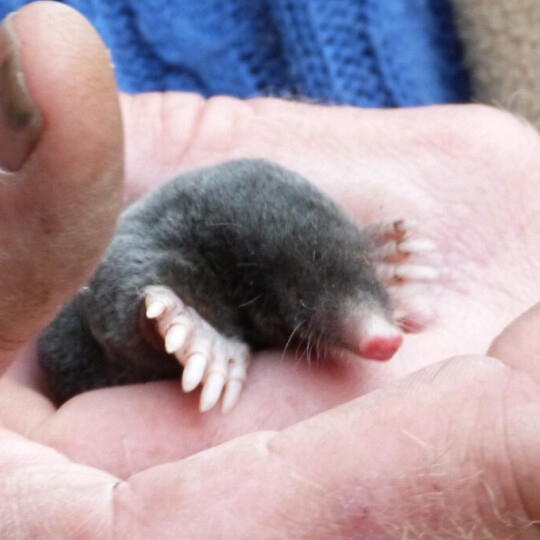"There's a mole in my garden.."
Love them or hate them, moles are marvellous creatures.
Aware that juvenile moles travel overground from their birthplace to seek their own area, a couple of days ago we got to see a youngster out in the open.
The young mole pictured above was running along the patio against the side of our house. We rescued it as it would have been of extreme interest to our 3 pets! Whilst the mole does have huge fore-paws, they have little defence against predators.
We were intrigued to see how mobile the nose is. What a treat to see one close up!
(After its brief 'photo-shoot', the juvenile was carefully carried to a spot where it could safely continue its journey).
8 Mole facts
- From the animal family Talpa europea, Moles are insectivores (insect eaters). They are solitary creatures that live in a system of tunnels, feeding on earthworms and insects that fall into their tunnels.
- Moles have tiny, poorly developed eyes. Despite their poor eyesight, they are very light sensitive.
- Moles use touch, hearing and smell to detect their prey and to help them sense danger. They have excellent hearing and extremely fast reflexes.
- They might emerge above-ground at night, to collect nesting material or look for food if the ground is particularly dry.
- An 80g mole consumes about 50g of worms a day. They eat every 4 hours, regardless of whether it is day or night.
Moles scour their network of tunnels during each feeding session, searching for food sources that have dropped or entered into the tunnels, making repairs where necessary to the network. - They can burrow up to 100 metres per night.
- The amount of soil moved by one mole has been calculated to be the equivalent of a person moving 4 tonnes in 10 minutes from a depth of half a metre..!
- Considered a pest in the UK, Moles are a protected species in Germany.
Appearance - Moles are 15 to 20cm long with grey to black velvety fur. They have very powerful, shovel-like front limbs, used for burrowing underground.
Life Cycle - The main breeding season is from February to June, each female rearing 3 to 5 young in an underground nest. The young leave the parental home after a few months and establish their own tunnel systems. A mole's life-span is 3-5 years.
Tunneling - Moles dig two types of tunnel, both of which are 4cm or 5cm in diameter. Those immediately beneath the surface are dug by males looking for females during the breeding season (February to June).
Deep holes, between 5cm and 20cm beneath the surface, are used for breeding and feeding. Tunnels can be up to several hundred metres long.
Silver lining to mole hills?
The earth pushed up into 'mole hills', (the bane of some gardeners) is well turned and, to use a gardening term, friable. To the rest of us, that means it's great to add to beds and planters. Occasional stones can be used to slow drainage when you re-pot your plants..
Tip - Gather mole hill soil when relatively fresh; buttercups and other spreading plants can colonise the loose soil surprisingly quickly.

